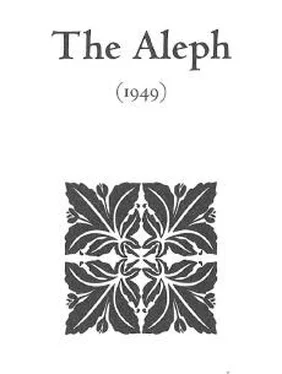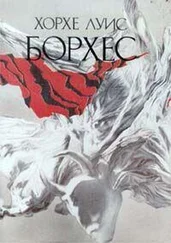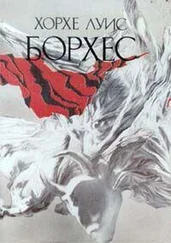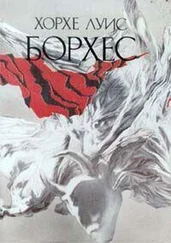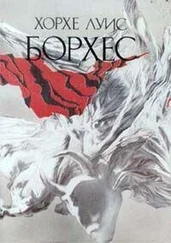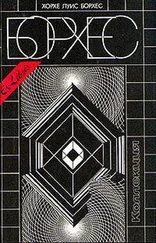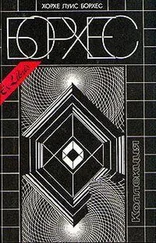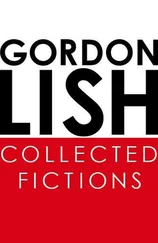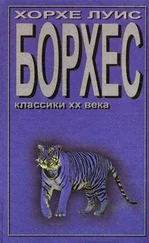Хорхе Борхес - Collected Fictions
Здесь есть возможность читать онлайн «Хорхе Борхес - Collected Fictions» весь текст электронной книги совершенно бесплатно (целиком полную версию без сокращений). В некоторых случаях можно слушать аудио, скачать через торрент в формате fb2 и присутствует краткое содержание. Год выпуска: 1999, ISBN: 1999, Издательство: Penguin (UK), Жанр: Старинная литература, на английском языке. Описание произведения, (предисловие) а так же отзывы посетителей доступны на портале библиотеки ЛибКат.
- Название:Collected Fictions
- Автор:
- Издательство:Penguin (UK)
- Жанр:
- Год:1999
- ISBN:9780140286809
- Рейтинг книги:5 / 5. Голосов: 1
-
Избранное:Добавить в избранное
- Отзывы:
-
Ваша оценка:
- 100
- 1
- 2
- 3
- 4
- 5
Collected Fictions: краткое содержание, описание и аннотация
Предлагаем к чтению аннотацию, описание, краткое содержание или предисловие (зависит от того, что написал сам автор книги «Collected Fictions»). Если вы не нашли необходимую информацию о книге — напишите в комментариях, мы постараемся отыскать её.
Collected Fictions — читать онлайн бесплатно полную книгу (весь текст) целиком
Ниже представлен текст книги, разбитый по страницам. Система сохранения места последней прочитанной страницы, позволяет с удобством читать онлайн бесплатно книгу «Collected Fictions», без необходимости каждый раз заново искать на чём Вы остановились. Поставьте закладку, и сможете в любой момент перейти на страницу, на которой закончили чтение.
Интервал:
Закладка:
* Those two criollos: There is no good word or short phrase for the Spanish word criollo. It is a word that indicates race, and so class; it always indicates a white-skinned person (and therefore presumed to be "superior") born in the New World colonies, and generally, though not always, to parents of Spanish descent (another putative mark of superiority). Here, however, clearly that last characteristic does not apply. JLB is saying with this word that the genetic or cultural roots of these men lie in Europe, and that their family's blood has apparently not mixed with black or Indian blood, and that they are fully naturalized as New Worlders and Argentines. The implicit reference to class (which an Argentine would immediately understand) is openly ironic.
* Costa Brava:"A small town in the district of Ramallo, a province of Buenos Aires, not to be confused with the island of the same name in the Paraná River, scene of various battles, including a naval defeat of Garibaldi" (Fishburn and Hughes). Bravo/a means "tough, mean, angry," etc.; in Spanish, therefore, Borges can say the toughs gave Costa Bravaits name, while in translation one can only say they gave the town its reputation.
Unworthy
* The Maldonado: The Maldonado was a stream that formed the northern boundary of the city of Buenos Aires at the turn of the century; the neighborhood around it, Palermo, was known as a rough part of town, and JLB makes reference to it repeatedly in his work. See the story "Juan Murafia," p. 370, for example. Thus, Fischbein and his family lived on the tough outskirts of the city. See also mention of this area on p. 359, below.
* I had started calling myself Santiago ... but there was nothing I could do about the Fischbein: The terrible thing here, which most Spanish-language readers would immediately perceive, is that the little red-headed Jewish boy has given himself a saint's name: Santiago is "Saint James," and as St. James is the patron saint of Spain, Santiago Matamoros, St. James the Moor Slayer. The boy's perhaps unwitting self-hatred and clearly conscious attempt to "fit in" are implicitly but most efficiently communicated by JLB in these few words.
* Juan Moreira: Agaucho turned outlaw (1819-1874) who was famous during his lifetime and legendary after death. Like Jesse James and Billy the Kid in the United States, he was seen as a kind of folk hero, handy with (in Moreira's case) a knife, and hunted down and killed by a corrupt police. Like the U. S. outlaws, his fictionalized life, by Eduardo Gutiérrez, was published serially in a widely read magazine, La Patria Argentina, and then dramatized, most famously by José de Podestà. See below, in note to "The Encounter," p. 368).
* Little Sheeny: Fishburn and Hughes gloss this nickname (in Spanish el rusito, literally "Little Russian") as being a "slang term for Ashkenazi Jews ... (as opposed to immigrants from the Middle East, who were known as turcos, 'Turks')." An earlier English translation gave this, therefore, as "sheeny," and I follow that solution. The slang used in Buenos Aires for ethnic groups was (and is) of course different from that of the English-speaking world, which leads to a barber of Italian extraction being called, strange to our ears, a gringo in the original Spanish version of the story "Juan Muraña" in this volume.
* Calle Junín: In Buenos Aires, running from the Plaza del Once to the prosperous northern district of the city; during the early years of the century, a stretch of Junín near the center of the city was the brothel district.
* Lunfardo: For an explanation of this supposed "thieves' jargon," see the Foreword to this volume, p. 347.
The Story from Rosendo Juárez
* The corner of Bolivar and Venezuela: Now in the center of the city, near the Plaza de Mayo, and about two blocks from the National Library, where Borges was the director. Thus the narrator ("Borges") is entering a place he would probably have been known to frequent (in "Guayaquil," the narrator says that "everyone knows" that he lives on Calle Chile, which also is but a block or so distant); the impression the man gives, of having been sitting at the table a good while, reinforces the impression that he'd been waiting for"Borges."But this area, some six blocks south of Rivadavia, the street "where the Southside began," also marks more or less the northern boundary of the neighborhood known as San Telmo, where Rosendo Juárez says he himself lives.
* His neck scarf: Here Rosendo Juárez is wearing the tough guy's equivalent of a tie, the chalina, a scarf worn much like an ascot, doubled over, the jacket buttoned up tight to make a large "bloom" under the chin. This garb marks a certain "type" of character.
* "You've put the story in a novel": Here "the man sitting at the table,"Rosendo Juárez, is referring to what was once perhaps JLB's most famous story, "Man on Pink Corner," in A Universal History of Iniquity, q.v., though he calls it a novel rather than a story.
* Neighborhood of the Maldonado: The Maldonado was the creek marking the northern boundary of the city of Buenos Aires around the turn of the century; Rosendo Juárez"words about the creek are true and mark the story as being told many years after the fact. The neighborhood itself would have been Palermo.
* Calle Cabrera: In Palermo, a street in a rough neighborhood not far from the center of the city.
* A kid in black that wrote poems: Probably Evaristo Carriego, JLB's neighbor in Palermo who was the first to make poetry about the "riffraff "—the knife fighters and petty toughs—of the slums. JLB wrote a volume of essays dedicated to Carriego.
* Moreira: See note to "Unworthy," p. 355.
* Chacarita: one of the city's two large cemeteries; La Recoleta was where the elite buried their dead, so Chacarita was the graveyard of the "commoners."
* San Telmo: One of the city's oldest districts, it was a famously rough neighborhood by the time of the story's telling. Fishburn and Hughes associate it with a popular song that boasts of its "fighting spirit" and note that the song would have given "an ironic twist to the last sentence of the story."
The Encounter
* Lunfardo: For an explanation of this supposed "thieves' jargon," see the Foreword to this volume, p. 347.
* One of those houses on Calle Junín: See note to "Unworthy," p. 355.
* Moreira: See note to "Unworthy," p. 355.
* Martín Fierro and Don Segundo Sombra: Unlike the real-life Juan Moreira, Martín Fierro and Don Segundo Sombra were fictional gauchos. Martín Fierrois the hero of the famous poem of the same name by José Hernández; the poem is centrally important in Argentine literature and often figures in JLB's work, as a reference, as a subject of meditation in essays, or rewritten (in "The End," in the volume Fictions, q.v.); his headstrong bravery and antiauthoritarianism are perhaps the traits that were most approved by the "cult of the gaucho" to which JLB alludes here. Don Segundo Sombra is the protagonist of a novel by Ricardo Gúiraldes; for this novel, see the note, below, to "The Gospel According to Mark," p. 399. It is interesting that JLB notes that the model for the gaucho shifts from a real-life person to fictional characters, perhaps to indicate that the true gaucho has faded from the Argentine scene and that (in a common Borges trope) all that's left is the memory of the gaucho.
* The Podestás and the Gutierrezes: The Podestà family were circus actors; in 1884, some ten years after the outlaw gaucho Juan Moreira's death, Juande Podestà put on a pantomime version of the life of Moreira."Two years later," Fishburn and Hughes tell us, "he added extracts from the novel [by Eduardo Gutiérrez]to his performance." The plays were extraordinarily successful. Eduardo Gutiérrez was a prolific and relatively successful, if none too "literary," novelist whose potboilers were published serially in various Argentine magazines. His Juan Moreira, however, brought himself and Moreira great fame, and (in the words of the Diccionario Oxford de Literatura Española e Hisf ano-Americana) "created the stereotype of the heroic gaucho."The dictionary goes on to say that"Borges claims that Gutiérrezis much superior to Fenimore Cooper."
Читать дальшеИнтервал:
Закладка:
Похожие книги на «Collected Fictions»
Представляем Вашему вниманию похожие книги на «Collected Fictions» списком для выбора. Мы отобрали схожую по названию и смыслу литературу в надежде предоставить читателям больше вариантов отыскать новые, интересные, ещё непрочитанные произведения.
Обсуждение, отзывы о книге «Collected Fictions» и просто собственные мнения читателей. Оставьте ваши комментарии, напишите, что Вы думаете о произведении, его смысле или главных героях. Укажите что конкретно понравилось, а что нет, и почему Вы так считаете.
